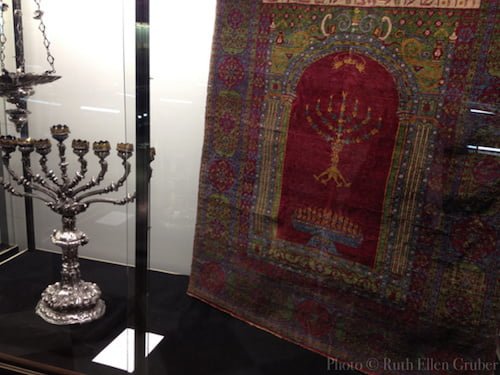 |
| In the 16th century Jewish cemetery on via Wiel, Padova. Photo: Gadi Luzzatto Voghera |
On a stiflingly hot day a couple weeks ago, I spent an afternoon in Padova (Padua), Italy, visiting some of the centuries-old Jewish heritage sites in the city -- they are being developed now as both a resource for local people and as an attractive itinerary for tourists and other visitors.
The sites I visited included the new Museo della Padova Ebraica (Museum of Jewish Padova) which opened in June. As I wrote on the Jewish Heritage Europe web site ahead of the opening, it is housed in the former “German,” synagogue, Sinagoga Tedesca, used by the Ashkenazic community, which was inaugurated in 1525 in the heart of the Jewish quarter, or ghetto, in the city’s historic center. (Note -- part of this post is a repost of my article on Jewish Heritage Europe.)
The synagogue, on via delle Piazze, was severely damaged during World War II when it was torched by local Fascists, and it stood derelict until it was completely rebuilt in 1998 (the ark was transferred to Tel Aviv in 1956). The museum exhibition includes before and after photos.

There is also an 18th century Megillah of Esther, a 16th century Torah scroll, exceptional silver torah ornaments, and several ketubot. A backlit photographic reproduction of the Ark occupies the space where the Ark once stood — the ark now being in Tel Aviv.
 |
| Add caption |
Two films are included in the exhibition. One is a general introduction to the history of the community. The other — projected on the walls of the sanctuary where the exhibit is located — tells the story of Padova Jews through the life stories of several prominent members of the community over the past five centuries or so, portrayed by actors. I was somewhat dismayed that this film does not include reference to any women in Padova Jewish history....perhaps there were no famous women, but it was the women who kept the community alive, and I believe that their role must also be highlighted, even if it simply means through exhibits dealing with food and marriage customs.....
Other sites I visited included the 16th century Italian rite synagogue, which is still used by the small local Jewish community, and the Jewish cemetery on via Wiel — dating from the 16th century and the oldest of the five Jewish cemeteries in the city. (You can download an article about these cemeteries HERE.)
 |
| Bimah in the Italian rite synagogue. Photo © Ruth Ellen Gruber |
The sanctuary of the Italian synagogue is a small, rather long and narrow space, with an elaborately carved Ark and a delicate wooden Bimah positioned to face each other from the middle of the long sides of the room. The Bimah is believed to have been carved from the wood of a single tree that fell in the botanical gardens.
 |
| Ark in the Italian rite synagogue in Padova. Photo © Ruth Ellen Gruber |
The Jewish cemetery behind a high brick wall in via Wiel, in central Padova near the Old Town and of ghetto, has been restored and is beautifully maintained by the Jewish community. Opened in 1529, with more than 90 16th century tombs, it is the oldest surviving Jewish cemetery in Padova and one of five Jewish cemeteries that remain in the city. (Fragments from two 15th century gravestones from a cemetery destroyed in 1509 are displayed in the city museum).
 |
Jewish cemetery on via Wiel, Padova, founded in 1529
|
Mainly because of them, Padova is believed to be the only place in Italy where devout followers make pilgrimages to the tombs of their masters. Indeed, Jewish community leaders say that these pilgrims often do not contact the Jewish community to obtain the key to the cemetery, but climb over the wall to pray, leave kvittlach (written messages) and light candles.
Katzenellenbogen gravestones are (rather charmingly) marked by the crest of a crouching Cat (“Katze” in German).
 |
| Add caption |
 |
| Add caption |
 |
| Add caption |
 |
Gravestone of Anselmo Del Banco (Asher Meshullam) d. 1532
|





No comments:
Post a Comment